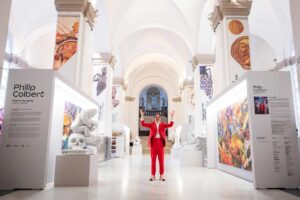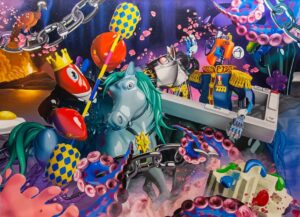A journey between past and present with an inclination towards the future, the ancient revisited in the contemporary, mosaic and digital, mythological tales in pop culture. A profound art-historical dialogue leads the works of Philip Corbet – Scottish born and British by adoption born in 1979 – to the discovery and revelation of an inseparable link between reality and imagination.

Philip Corbet, House of the Lobster, installation view at Museo Archeologico Nazionale di Napoli, photo Valentina Cosentino, courtesy Museo Archeologico Nazionale di Napoli – MANN
In a symbolism rich in colourful languages and surreal times, Corbet’s art is moulded in the iconographic collection of the National Archaeological Museum of Naples, with the artist’s first site-specific exhibition in an archaeological institution entitled House of the Lobster. The lobster – alter ego and aesthetic protagonist – replaces the historical characters of mosaics, frescoes and statues, in a series of large-scale oil paintings on canvas and sculptures in marble, bronze and steel, in a postmodern and hyper pop reworking of history. Philip Corbet’s obsession with the lobster is not only for aesthetic purposes, but as much for the symbolic reiteration it has had in ancient history. The exhibition in the museum atrium amplifies its contemporary connection to themes such as mortality, conflict and the cyclical nature of existence.

Philip Corbet, House of the Lobster, 2023, (Snake hunt relif, 60 x 66 x 16 cm, marmo, Seated Lobster Portrit (with column), 200×150 cm, olio su tela), photo ©Ivan Romano / Getty Images, courtesy Museo Archeologico Nazionale di Napoli – MANN
The most emblematic example of this is represented by the commonality between the Pompeian marine mosaic and the painted steel sculpture Lobstar Octopus, as a visual metaphor that transcends time and empathises with the viewer through the sinuous coloured forms and regularity of the fragments. This work is the focal point of a series of exhibited works entitled Pompeii Series that echo those in the House of the Faun found from 1830 to 1832, including After Battle of Issus Mosaic as a tribute to the famous Alexander the Great mosaic (currently under restoration). Colbert takes the composition and transplants it into the surreal and apocalyptic landscape of his retro-futuristic world of lobsters. In this way, the pop artist invites viewers to reconsider the enduring impact of historical art in the context of today’s rapidly changing cultural landscape. The themes of battle are echoed in further exhibited works, playing between pure marble and bronze and the sheen of chrome-plated steel, symbolising more contemporary internal and external social struggles.

Philip Corbet, House of the Lobster, installation view at Museo Archeologico Nazionale di Napoli, photo Valentina Cosentino, courtesy Museo Archeologico Nazionale di Napoli – MANN
The lost voids left by the time of archaeology are Philip Corbet’s visceral imagination because they generate suspended and surreal, new and recreated times. «Imagination, which is always projected towards the future, becomes poetry when it encounters the past: I would like to convey this message to all visitors, especially the youngest» these words – spoken in a statement during the opening of the exhibition – emphasise how time, space, history and contemporaneity can hover together in relation to the human experience, passing on what has been in a different language. The lobster is the medium of a message that involves everything and everyone in an energetic new pop art.
Info:
Philip Corbet. House of the Lobster
26/01 – 01/04/2024
Museo Archeologico Nazionale di Napoli
Piazza Museo 19, Napoli
www.mann-napoli.it

Art Curator and Art Advisor, graduated in Visual Arts and Cultural Mediation, with Master in Curatorial Practices, born in 1995, lives in Naples. He collaborates with Galleries and Independent Spaces, his research is mainly focused on Emerging Painting, with a careful and inclined gaze also on other forms of aesthetic language.






NO COMMENT